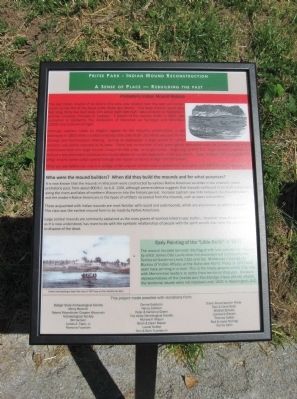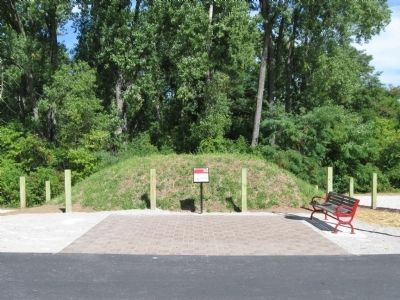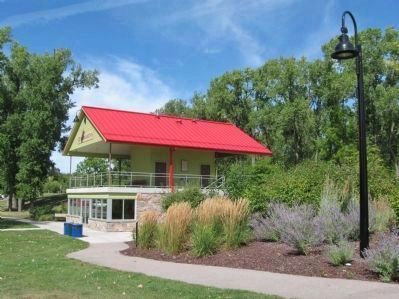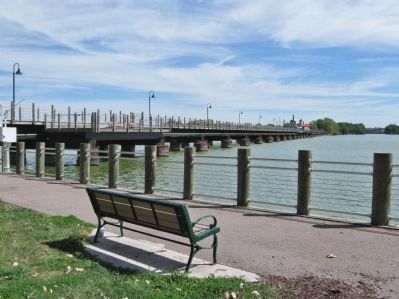Near Menasha in Winnebago County, Wisconsin — The American Midwest (Great Lakes)
Fritse Park - Indian Mound Reconstruction
A Sense of Place Rebuilding the past
Prehistoric Indian Mound Replica
The last Indian mound of its kind in this area was located near this spot and known locally as the Hill of the Dead (Little Butte des Morts). This large mound, about sixty feet long, thirty feet wide, and about eight feet high, was surveyed by Wisconsin's premier scientist, Increase A. Lapham. A sketch of the mound, made in 1851, was published in Lapham's The Antiquities of Wisconsin as Surveyed and Described (1855) and is shown at right.
Although Lapham made an elegant appeal for the mound's preservation, it was destroyed in 1863 when a trestle crossing Little Butte des Morts was built for Chicago and Northwestern Railway. During its destruction a large pocket of human remains was plainly exposed at its base. There was no mention of any grave goods associated with the human remains. It is unfortunate that this large mound, unique for this area, no longer exists. Beginning ca.500 B.C. large conical mounds were built at a new prominent locations over burial places for certain segments of the population. Later, between 700 and 1100 A.D. effigy mound construction spread through this region (as found at High Cliff State Park).
What you see before you now is a vestige of the original conical mound believed to have been built 2000 to 2500 years ago.
Who were the mound builders? When did they build the mounds and for what purpose?
It is now known that the mounds in Wisconsin were constructed by various native American societies in the relatively recent prehistoric past, from about 800 B.C. to A.D. 1200, although some evidence suggests that mounds continued to be built occasionally along the rivers and lakes of northern Wisconsin into the historic period. Increase Lapham saw links between the mound builders and the modern Native Americans in the types of artifacts recovered from the mounds, such as pipes and pottery.
Those acquainted with Indian mounds are most familiar with round and oval mounds, which are also known as conical mounds. This class was the earliest mound form to be made by Native Americans.
Large conical mounds are commonly explained as the mass graves of warriors killed in epic battles. However, mound construction as it is now understood, has more to do with the symbolic relationships of people with the spirit worlds than with the practice to dispose of the dead.
Early Painting of the "Little Butte" in 1827
The mound (located beneath the flag at left) was painted on the spot by artist James Otto Lewis when he accompanied commissioners Territorial Governor Lewis Cass and Col. McKenney (head of the Bureau of Indian Affairs) at the Butte des Morts Treaty of 1827 and seen here arriving in a boat. This is the treaty ground where they met with Menominee leaders to settle their territorial disputes. Because representatives of the Oneida and Stockbridge tribes did not attend, the territorial issues were not resolved until 1831 in Washington, D.C.
This project made possible with donations from: Badger State Archaeological Society Merry Beverlin Robert Ritzenthaler Chapter, Wisconsin Archaeological Society Bill Carlson James A. Clark, Jr. Ramona Fountain Donna Gasbarro Nancy Graham Peter & NaVonne Green Fox Valley Genealogical Society Richard P. Mason Brian & Dawn Mason Laurel Nobbe Don & Barb Nussbaum Diane Perschbacher Phifer Dick & Carol Rank Mildred Schultz Lawrence Sievert Thomas Sutter Bud & Joyce Tschirgi Donna Zahn
Topics. This historical marker is listed in these topic lists: Cemeteries & Burial Sites • Native Americans. A significant historical year for this entry is 1851.
Location. 44° 12.335′ N, 88° 28.235′ W. Marker is near Menasha, Wisconsin, in Winnebago County. Marker can be reached from North Lake Street, 0.1 miles north of Jacobsen Road (County Highway PP), on the right when traveling north. Marker is in Fritsie Park along the Fox Cities Trestle / Friendship Trail. Touch for map. Marker is
at or near this postal address: 899 North Lake Street, Neenah WI 54956, United States of America. Touch for directions.
Other nearby markers. At least 8 other markers are within 2 miles of this marker, measured as the crow flies. Menasha Lock (approx. half a mile away); Curtis Reed (approx. 1.1 miles away); Historic Wisconsin Avenue Commercial District (approx. 1.3 miles away); 1st Sergeant Elmer J. Burr (approx. 1½ miles away); Jean Nicolet Monument (approx. 1½ miles away); Specialist Fourth Class Kenneth Stumpf (approx. 1½ miles away); Menashas Isle of Valor (approx. 1½ miles away); Soldiers and Sailors Memorial Building (approx. 1.6 miles away). Touch for a list and map of all markers in Menasha.
More about this marker. painting caption:
Commissioned painting by James Otto Lewis of 1827 Treaty at Little Lake Butte des Morts
Also see . . . Legends of Butte des Morts. Wisconsin Historical Society. “[The hill] was twelve feet high, sixty feet long north and south, and thirty-five feet wide. It stood in the midst of a wide prairie, 300 feet back from the lake shore, on a point of land that was thirty feet above the level of the lake, and the only high land on the west side of the lake.” (Submitted on January 11, 2014.)
Credits. This page was last revised on June 16, 2016. It was originally submitted on January 11, 2014, by Keith L of Wisconsin Rapids, Wisconsin. This page has been viewed 1,185 times since then and 75 times this year. Photos: 1, 2, 3, 4. submitted on January 11, 2014, by Keith L of Wisconsin Rapids, Wisconsin.



